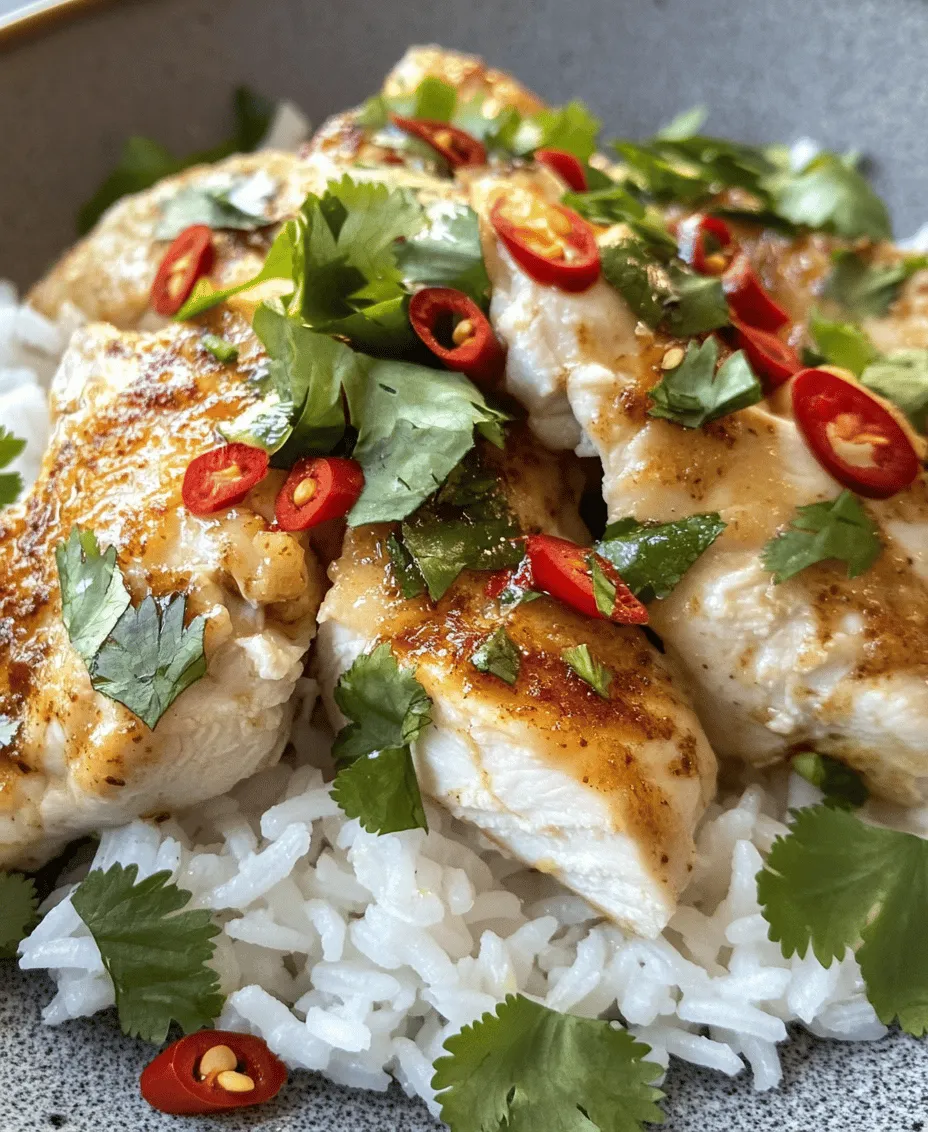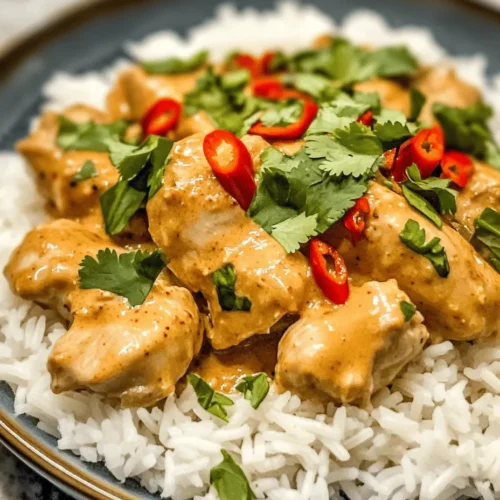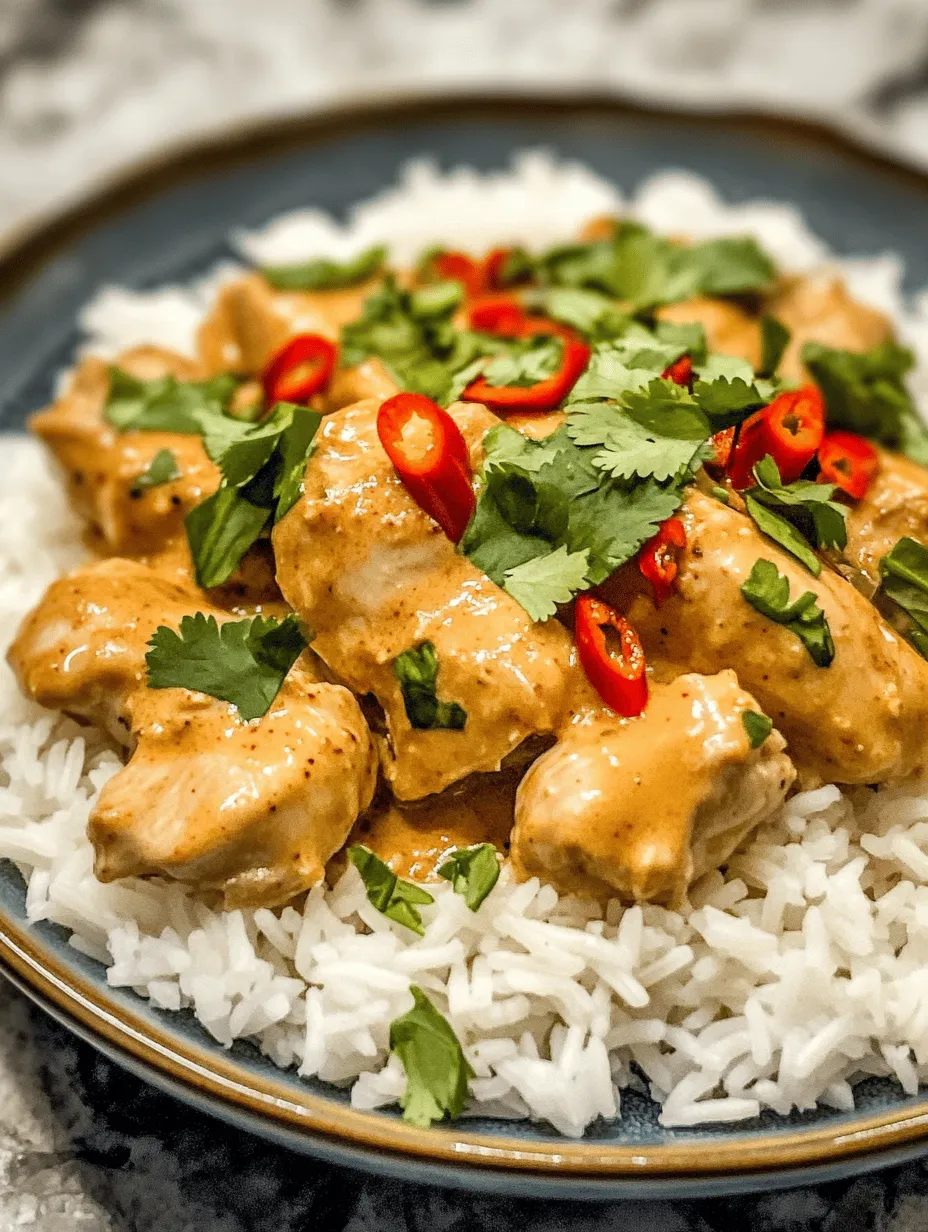Introduction
Brazilian cuisine is a vibrant tapestry of flavors, colors, and traditions, reflecting the country’s rich cultural heritage. Influenced by indigenous peoples and a blend of African, European, and Asian culinary practices, Brazilian dishes often highlight fresh ingredients, spices, and bold flavors. From the mouthwatering feijoada to the sweet and savory brigadeiro, each dish tells a story that connects the past with the present. Among these culinary gems is the Spicy Brazilian Coconut Chicken, a dish that combines the tropical essence of Brazil with the warmth of spices, making it a delightful addition to any meal.
At the heart of Brazilian cooking is the use of coconut and spices, both of which play a pivotal role in many traditional recipes. Coconut, which thrives in Brazil’s tropical climate, is used in various forms—from shredded coconut to coconut milk—adding a creamy richness to dishes. Spices such as cumin, coriander, and chili peppers infuse meals with warmth and depth, creating a harmonious balance of flavors that is quintessentially Brazilian.
The Spicy Brazilian Coconut Chicken is a perfect example of this fusion of flavors. This dish features succulent chicken thighs simmered in a luscious coconut milk sauce, enhanced with aromatic spices and a hint of acidity from lime juice. It is both comforting and invigorating, making it an ideal choice for a weeknight dinner or a special gathering. The combination of coconut and spices not only tantalizes the palate but also offers a medley of health benefits, making this dish as nourishing as it is delicious.
Coconut and chicken are both packed with nutrients that contribute to a healthy diet. Coconut, for instance, is rich in medium-chain triglycerides (MCTs), which can boost metabolism and provide a quick source of energy. It also contains essential vitamins and minerals, such as potassium, magnesium, and iron. On the other hand, chicken, particularly when using thighs, is an excellent source of protein, providing the body with the necessary amino acids for muscle growth and repair. Together, these ingredients create a dish that is not only flavorful but also beneficial for your health.
Exploring the Ingredients
The Star of the Dish: Chicken Thighs
When it comes to crafting the perfect Spicy Brazilian Coconut Chicken, the choice of chicken is crucial. Chicken thighs are the star ingredient of this dish, and for good reason. Unlike chicken breasts, which can often be dry and lacking in flavor, chicken thighs are known for their rich taste and tender texture. They contain more fat than breasts, which helps them retain moisture during cooking, resulting in a succulent dish that is bursting with flavor.
Benefits of Boneless, Skinless Chicken Thighs
Using boneless, skinless chicken thighs in this recipe not only simplifies preparation but also enhances the dining experience. Boneless thighs cook evenly and are easy to cut into bite-sized pieces, making them ideal for this dish. Additionally, removing the skin reduces the overall fat content while still allowing you to enjoy the juiciness that thighs provide. This makes boneless, skinless chicken thighs a healthier, yet equally delicious, option for your Spicy Brazilian Coconut Chicken.
Why Thighs are Preferred Over Breasts
The preference for chicken thighs over breasts in this recipe stems from their unique qualities. Thighs have a richer flavor profile, which pairs beautifully with the aromatic spices and creamy coconut milk. Moreover, their slightly higher fat content contributes to a more satisfying mouthfeel and enhances the dish’s overall depth. When simmered in the coconut sauce, chicken thighs absorb the spices and flavors, creating a symphony of taste that is both comforting and exhilarating.
The Creamy Base: Coconut Milk
Coconut milk is the heart of this dish, providing a creamy base that envelops the chicken in a luscious sauce. This versatile ingredient is made by blending the flesh of mature coconuts with water, resulting in a rich liquid that is both sweet and savory. Coconut milk is not only a staple in Brazilian cooking but also in many tropical cuisines around the world, celebrated for its ability to add depth and creaminess to dishes.
Nutritional Benefits of Coconut Milk
In addition to its delightful flavor, coconut milk offers an array of nutritional benefits. It is high in healthy fats, particularly MCTs, which can support weight management and boost energy levels. Coconut milk is also rich in vitamins C, E, and several B vitamins, which play essential roles in maintaining good health. Furthermore, it contains minerals such as iron, magnesium, and potassium, contributing to its overall nutritional profile.
How Coconut Milk Enhances Flavor and Texture
Coconut milk not only adds creaminess but also enhances the flavor of the dish. Its natural sweetness balances out the heat from the spices, creating a well-rounded flavor profile. The richness of the coconut milk serves as the perfect canvas for the spices, allowing them to shine without overpowering the dish. As the chicken simmers in the coconut milk, it absorbs the flavors, resulting in a tender, flavorful dish that is sure to impress.
Aromatic Foundations: Onions, Garlic, and Ginger
No Brazilian dish would be complete without a solid foundation of aromatics. In this recipe, onions, garlic, and ginger play a crucial role in building flavor. Onions provide a natural sweetness and depth, while garlic adds a pungent, savory note that enhances the overall taste. Ginger brings a warm, spicy element that complements the heat from the chili peppers and adds a refreshing zing to the dish.
The Importance of Aromatics in Cooking
Aromatics are essential in cooking as they create a flavorful base that elevates the dish. When sautéed, onions, garlic, and ginger release their essential oils and flavors, infusing the dish with depth and aroma. This process not only enhances the overall taste but also creates an enticing fragrance that draws people to the kitchen.
Health Benefits of Garlic and Ginger
Beyond their flavor contributions, garlic and ginger both offer numerous health benefits. Garlic is known for its immune-boosting properties and has been linked to various health benefits, including improved heart health and reduced inflammation. Ginger, on the other hand, is renowned for its anti-inflammatory and digestive properties, making it a beneficial addition to any meal. Together, these aromatics not only enhance the flavor of the Spicy Brazilian Coconut Chicken but also contribute to its nutritional value.
Spicing it Up: Chili Peppers, Paprika, Cumin, and Coriander
The spice blend in this dish is what truly sets it apart, bringing warmth and complexity to the coconut sauce. Chili peppers add heat, while paprika, cumin, and coriander provide a rich, earthy flavor. Each of these spices plays a unique role, creating a harmonious blend that characterizes Brazilian cuisine.
Adjusting the Heat: A Guide to Chili Peppers
Chili peppers are the key to achieving the desired level of heat in your Spicy Brazilian Coconut Chicken. Depending on your preference, you can choose from a variety of chili peppers, each offering a different heat level and flavor profile. For a milder dish, opt for poblano or Anaheim peppers; for a medium level of heat, consider jalapeños or serranos; and for those who enjoy a fiery kick, habaneros or Thai bird chilies can bring the heat. Remember, you can always adjust the number of peppers used to suit your taste, ensuring that everyone at the table can enjoy this flavorful dish.
Flavor Profiles of Paprika, Cumin, and Coriander
Paprika, cumin, and coriander each contribute distinct flavor profiles that enrich the dish. Paprika, with its sweet and smoky notes, adds depth and color, making the sauce visually appealing. Cumin offers a warm, earthy flavor that enhances the overall richness of the dish, while coriander brings a bright, citrusy note that balances out the spices. This combination creates a complex and satisfying flavor profile that is characteristic of Brazilian cooking.
The Zesty Touch: Lime Juice
To round out the flavors in your Spicy Brazilian Coconut Chicken, a splash of lime juice is essential. The acidity from lime juice cuts through the richness of the coconut milk, creating a well-balanced dish that is both refreshing and satisfying. Lime juice not only enhances the flavors but also brightens the overall taste, making each bite a burst of deliciousness.
The Role of Acidity in Balancing Flavors
Acidity plays a crucial role in cooking, as it helps to balance flavors and enhance the overall taste of a dish. In the case of Spicy Brazilian Coconut Chicken, lime juice acts as a counterpoint to the richness of the coconut milk and the heat from the spices. This balance is key to creating a dish that is enjoyable and satisfying, ensuring that the flavors complement rather than overwhelm one another.
Preparation Steps in Detail
Marinating the Chicken: Importance and Techniques
Marinating the chicken is a pivotal step in the preparation of Spicy Brazilian Coconut Chicken. This process allows the flavors of the spices to penetrate the meat, enhancing its taste and tenderness. A well-executed marinade can transform ordinary chicken into a flavor-packed delight that is sure to impress.
How Marination Enhances Flavor and Tenderness
The marination process works in two significant ways. First, it infuses the chicken with the bold flavors of the spices, ensuring that every bite is bursting with taste. Second, marinating helps to tenderize the chicken, making it more succulent and enjoyable to eat. The combination of acid from the lime juice and the enzymes in the marinade breaks down the proteins in the chicken, resulting in a tender, juicy final dish.
Recommended Marinating Time for Optimal Flavor
For optimal flavor infusion, it is recommended to marinate the chicken for at least 30 minutes to an hour. If time allows, marinating for several hours or even overnight can yield even more intense flavors. Just be sure to keep the chicken refrigerated during the marination process to ensure food safety.
Sautéing the Aromatics: Techniques for Maximum Flavor
Once the chicken has marinated, it is time to sauté the aromatics. Begin by heating a generous amount of oil in a large skillet or Dutch oven over medium heat. Add the diced onions and sauté until they become translucent and fragrant. Next, add the minced garlic and ginger, stirring continuously to prevent burning. This technique will release the essential oils from the aromatics, creating a wonderfully fragrant base for your Spicy Brazilian Coconut Chicken.
As the aromatics cook, they will develop a rich flavor that will serve as the foundation for the dish. Once they are fragrant and softened, it is time to add the marinated chicken, allowing it to brown slightly before adding the coconut milk and spices. This step not only enhances the flavor of the chicken but also helps to build a rich, savory sauce that will envelop the dish in deliciousness.
In this vibrant exploration of Brazilian flavors, the Spicy Brazilian Coconut Chicken promises to be a culinary adventure that brings the warmth of Brazil to your kitchen. With each ingredient contributing to the dish’s richness, preparing this meal will not only satisfy your palate but also nourish your body. As we continue to delve into the preparation and cooking methods, you’ll discover how to create this flavorful masterpiece and impress your family and friends with a taste of Brazil.

Tips for Sautéing Onions to Perfection
Sautéing onions is a fundamental technique in many recipes, including our Spicy Brazilian Coconut Chicken. To achieve perfectly sautéed onions, start by slicing them evenly to ensure even cooking. Use a large skillet or frying pan with a heavy bottom to help distribute heat evenly. Begin by heating your oil over medium heat until it shimmers. Add a pinch of salt to the onions as they cook; this helps draw out moisture and enhances their sweetness. Stir frequently to prevent them from burning, and aim for a golden-brown color, which usually takes about 5 to 10 minutes. The caramelization of onions adds depth and richness to your dish, setting a flavorful foundation for the chicken and sauce.
The Role of Heat in Releasing Aromatic Oils
Heat plays a crucial role in cooking, particularly when it comes to releasing the aromatic oils from spices and herbs. For your Spicy Brazilian Coconut Chicken, the combination of heat and the natural oils in the ingredients helps to create a fragrant base. When you sauté the onions and garlic, the heat causes the cells to break down, releasing their essential oils into the dish. This is why it’s essential to control the heat level: too high, and the onions may burn; too low, and they may not develop the rich flavors you desire. Keep the heat at medium, allowing the flavors to meld beautifully as you cook.
Cooking the Chicken: Ensuring Perfectly Cooked Thighs
When it comes to chicken thighs, ensuring they are cooked thoroughly while remaining juicy is key to a successful dish. Start by seasoning your chicken thighs generously with salt and pepper, allowing the seasoning to penetrate the meat. In your Dutch oven or heavy skillet, heat oil over medium-high heat and add the chicken thighs skin-side down. Avoid crowding the pan; this allows for proper browning. Cook for about 7 to 8 minutes per side until they are golden brown and cooked through. The internal temperature should reach 165°F (75°C). Using a meat thermometer can help you avoid overcooking, which can dry out the chicken.
Tips for Browning Chicken for Flavor
Browning chicken is essential for building flavor. The Maillard reaction creates a complex flavor profile that enhances your dish. To achieve perfect browning, ensure your chicken is dry before adding it to the hot pan; moisture can create steam instead of allowing for a nice sear. Do not move the chicken too much while it cooks; let it sit in the pan to develop a beautiful crust. If your pan is overcrowded, consider cooking in batches to ensure each piece gets the attention it needs for optimal browning.
Understanding Cooking Times for Safety and Taste
Cooking times are crucial for both safety and flavor. For chicken thighs, after browning, you will need to simmer them in the sauce for another 15-20 minutes. This not only ensures the chicken is cooked through but also allows it to absorb the delicious flavors of the coconut milk and spices. Remember to check the internal temperature, which should reach 165°F (75°C) when fully cooked. Using a meat thermometer is your best bet for ensuring food safety while achieving perfectly cooked chicken.
Creating the Sauce: Bringing it All Together
Once your chicken is browned, it’s time to create the sauce that will envelop it in flavor. Remove the chicken from the pan and set it aside. In the same pan, add more oil if necessary, then stir in your aromatics—such as garlic, ginger, and chili peppers—allowing them to cook just until fragrant. Next, slowly pour in the coconut milk, scraping the bottom of the pan to deglaze and incorporate all those wonderful browned bits. Adding spices like cumin and coriander at this stage will further deepen the flavor profile. Return the chicken to the pan, nestling it in the sauce, and bring it to a gentle simmer.
The Importance of Simmering for Flavor Development
Simmering is a critical step in flavor development. Once your chicken is back in the pan with the sauce, reduce the heat to low and allow it to simmer gently. This helps the chicken absorb the delicious flavors of the sauce while keeping it tender and juicy. Continue to simmer for 15-20 minutes, covered, allowing the spices to meld beautifully. As the sauce thickens, it will coat the chicken in a rich, creamy layer of flavor, making each bite a delight.
How to Check for Doneness: Temperature Guidelines
To ensure your chicken is perfectly cooked, checking the internal temperature is essential. Insert a meat thermometer into the thickest part of the thigh, avoiding bone, which can give a false reading. The chicken should reach an internal temperature of 165°F (75°C). If it hasn’t reached that temperature, allow it to simmer a bit longer and re-check. Once done, let the chicken rest for a few minutes before serving, which helps the juices redistribute throughout the meat, resulting in succulent, flavorful chicken.
Serving Recommendations
Ideal Pairings: Serving with Jasmine Rice
Jasmine rice is an excellent companion for Spicy Brazilian Coconut Chicken. Its fragrant aroma and slightly sticky texture make it perfect for soaking up the creamy coconut sauce. When serving, spoon a generous helping of chicken over a bed of jasmine rice, allowing the flavors to meld beautifully on the plate. The subtle nutty flavor of jasmine rice contrasts well with the spices, enhancing the overall dining experience.
Benefits of Jasmine Rice as a Side Dish
Jasmine rice is not only delicious but also offers several benefits. It is a good source of carbohydrates, providing energy, and is gluten-free, making it suitable for those with gluten sensitivities. Additionally, jasmine rice has a pleasant aroma and a soft texture that complements the spicy and creamy elements of the chicken dish. Its quick cooking time makes it a convenient choice for weeknight meals.
Alternative Rice Options for Different Preferences
If jasmine rice isn’t available, there are plenty of alternatives. Basmati rice is another aromatic option that pairs beautifully with the dish, providing a slightly nutty flavor. For a healthier choice, consider brown rice or quinoa, which adds fiber and protein. Cauliflower rice can also serve as a low-carb option, offering a similar texture while keeping the dish light.
Suggested Accompaniments: Steamed Broccoli and Salad
To create a balanced meal, consider serving your Spicy Brazilian Coconut Chicken with steamed broccoli and a fresh salad. Broccoli adds a pop of color and essential nutrients, while the slight bitterness of the greens balances the richness of the chicken. A salad made with mixed greens, cherry tomatoes, and a light vinaigrette can provide a refreshing contrast to the warm, spicy chicken, making for a well-rounded plate.
How to Create a Balanced Meal with Vegetables
Incorporating vegetables into your meal not only adds nutrition but also vibrancy and texture. Aim for a variety of colors on the plate—think greens from broccoli, reds from tomatoes, and the golden tones of the chicken. Consider including roasted carrots or bell peppers for added sweetness and flavor. The goal is to create a meal that is visually appealing and nutritionally balanced.
Flavor Pairings that Complement the Chicken Dish
When it comes to flavor pairings, consider adding a squeeze of lime juice to your dish before serving. The acidity brightens the flavors and cuts through the richness of the coconut milk. Fresh herbs, such as cilantro or parsley, can also add a burst of freshness. If you enjoy heat, additional sliced chili peppers can be served on the side for those who like an extra kick.
Culinary Tips for Success
Adjusting Spice Levels: Customizing Heat to Your Preference
One of the beauties of cooking is the ability to tailor dishes to your liking. When preparing your Spicy Brazilian Coconut Chicken, feel free to adjust the spice levels to match your palate. If you prefer a milder dish, consider reducing the number of chili peppers or opting for a milder variety. Conversely, if you love heat, add more chili or even a touch of cayenne pepper. Taste as you go, ensuring the flavors are balanced and enjoyable for you and your guests.
Ensuring Creaminess: Tips for Working with Coconut Milk
To achieve the ultimate creaminess in your coconut sauce, choose full-fat coconut milk. It provides a rich texture that enhances the dish. When opening the can, stir well to combine the cream and liquid, ensuring an even consistency. If you find the sauce too thick, you can thin it out with a splash of chicken broth or water. Conversely, if you want a thicker sauce, let it simmer uncovered for a few extra minutes to allow some of the liquid to evaporate.
Storing Leftovers: Best Practices for Keeping it Fresh
If you find yourself with leftovers, proper storage is key to preserving the dish’s flavors. Allow the chicken and sauce to cool completely before transferring them to an airtight container. Store in the refrigerator for up to 3-4 days. When reheating, do so gently over low heat to prevent the chicken from drying out. If the sauce seems thickened, add a splash of coconut milk or broth to restore its creaminess.
Cultural Significance of the Dish
Brazilian Culinary Traditions and Influence of Indigenous Ingredients
Spicy Brazilian Coconut Chicken is a dish that reflects Brazil’s rich culinary heritage, influenced by indigenous ingredients and diverse cultural traditions. The use of coconut, for example, highlights the tropical abundance of the region, while spices and chili peppers showcase the melting pot of flavors brought by African, Portuguese, and indigenous cuisines. This dish embodies the warmth and hospitality characteristic of Brazilian culture, where food is often a centerpiece of family gatherings.
The Popularity of Coconut in Brazilian Cooking
Coconut is a staple in Brazilian cooking, celebrated for its versatility and flavor. It appears in many traditional dishes, from savory stews to sweet desserts. The creamy texture of coconut milk enhances the richness of dishes, making it a beloved ingredient across the country. Its popularity can be traced back to the coastal regions of Brazil, where coconuts are plentiful, and its use has spread to various culinary applications.
How This Recipe Reflects the Diversity of Brazilian Cuisine
This recipe not only offers a taste of Brazil but also showcases the country’s diverse culinary landscape. By combining coconut, spices, and chicken, it reflects the harmonious blend of flavors that defines Brazilian cooking. Each bite delivers a unique experience, highlighting the balance of heat, creaminess, and the vibrant essence of tropical ingredients.
Conclusion
Spicy Brazilian Coconut Chicken is more than just a meal; it’s an exploration of vibrant flavors and cultural heritage. With its rich combination of spices and creamy coconut milk, this dish tantalizes the taste buds while providing a hearty and satisfying dining experience. The health benefits from the chicken and the accompanying vegetables further enhance its appeal, making it a wonderful choice for any occasion.
As you embark on your culinary journey through Brazilian cuisine, let this dish inspire you to explore more recipes that reflect the diversity and richness of this vibrant culture. Cooking is not just about the food; it’s about the joy of creating and sharing meals with loved ones. So gather your ingredients, follow the steps, and enjoy the delightful flavors of Spicy Brazilian Coconut Chicken—it’s a dish that’s sure to impress your family and friends while bringing a taste of Brazil to your table.



